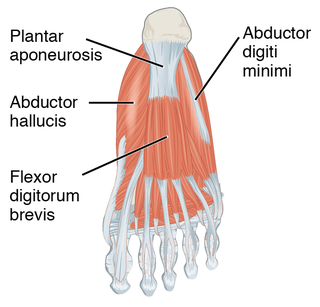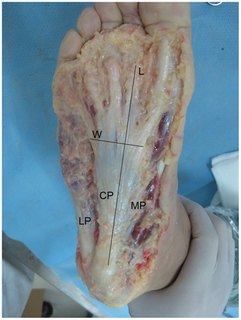A podiatrist, also known as a podiatric physician or foot and ankle surgeon, is a medical professional devoted to the treatment of disorders of the foot, ankle, and lower extremity. The term originated in North America but has now become the accepted term in the English-speaking world for all practitioners of podiatric medicine.

Flip-flops are a type of sandal, typically worn as a form of casual wear. They consist of a flat sole held loosely on the foot by a Y-shaped strap known as a toe thong that passes between the first and second toes and around both sides of the foot or can be a hard base with a strap across all the toes.

Podiatry is a branch of medicine devoted to the study, diagnosis, and medical and surgical treatment of disorders of the foot, ankle, and lower extremity. The term podiatry came into use in the early 20th century in the United States and is now used worldwide, including in countries such as the United Kingdom, Australia, and Canada.

Pes cavus, also known as high arch, is a human foot type in which the sole of the foot is distinctly hollow when bearing weight. That is, there is a fixed plantar flexion of the foot. A high arch is the opposite of a flat foot and is somewhat less common.

The plantar fascia is the thick connective tissue (aponeurosis) which supports the arch on the bottom of the foot. It runs from the tuberosity of the calcaneus forward to the heads of the metatarsal bones.

Plantar fasciitis is a disorder of the connective tissue which supports the arch of the foot. It results in pain in the heel and bottom of the foot that is usually most severe with the first steps of the day or following a period of rest. Pain is also frequently brought on by bending the foot and toes up towards the shin. The pain typically comes on gradually, and it affects both feet in about one-third of cases.

Diseases of the foot generally are not limited, that is they are related to or manifest elsewhere in the body. However, the foot is often the first place some of these diseases or a sign or symptom of others appear. This is because of the foot's distance from the central circulation, the heart and its constant exposure to pressures from the ground and the weight of the body.

An enthesopathy refers to a disorder involving the attachment of a tendon or ligament to a bone. This site of attachment is known as the enthesis . If the condition is known to be inflammatory, it can more precisely be called an enthesitis.

Sever's Disease, otherwise known as apophysitis of the calcaneus, is an inflammation of the growth plate in the heel of growing children. The condition presents as pain in the heel and is caused by repetitive stress to the heel and is thus particularly common in active children. It usually resolves when the bone has completed growth or activity is lessened.

A calcaneal spur is a bony outgrowth from the calcaneal tuberosity. Calcaneal spurs are typically detected by x-ray examination. It is a form of exostosis.

A removable shoe insert, otherwise known as a foot orthosis, insole or inner sole accomplishes many number of purposes, including daily wear comfort, height enhancement, plantar fasciitis treatment, arch support, foot and joint pain relief from arthritis, overuse, injuries, leg length discrepancy, and other causes such as orthopedic correction and athletic performance.
Foot and ankle surgery is a sub-specialty of orthopedics and podiatry that deals with the treatment, diagnosis and prevention of disorders of the foot and ankle. Orthopaedic surgeons are medically qualified, having been through four years of college, followed by 4 years of medical school to obtain an M.D. or D.O. followed by specialist training as a resident in orthopaedics, and only then do they sub-specialise in foot and ankle surgery. Training for a podiatric foot and ankle surgeon consists of four years of college, four years of podiatric medical school (D.P.M.), 3–4 years of a surgical residency and an optional 1 year fellowship.

Orthotics is a medical specialty that focuses on the design and application of orthoses. An orthosis is "an externally applied device used to modify the structural and functional characteristics of the neuromuscular and skeletal system". An orthotist is the primary medical clinician responsible for the prescription, manufacture and management of orthoses. An orthosis may be used to:

Locomotor effects of shoes are the way in which the physical characteristics or components of shoes influence the locomotion neuromechanics of a person. Depending on the characteristics of the shoes, the effects are various, ranging from alteration in balance and posture, muscle activity of different muscles as measured by electromyography (EMG), and the impact force. There are many different types of shoes that exist, such as running, walking, loafers, high heels, sandals, slippers, work boots, dress shoes, and many more. However, a typical shoe will be composed of an insole, midsole, outsole, and heels, if any. In an unshod condition, where one is without any shoes, the locomotor effects are primarily observed in the heel strike patterns and resulting impact forces generated on the ground.

Zheng Gu Shui is a traditional Chinese liniment. This external analgesic is known to relieve qi and blood stagnation, promote healing, and soothe pain. The formula is known as Dit da jow in Cantonese or die da jiu in Mandarin.
Plantar calcaneal bursitis is a medical condition in which there is inflammation of the plantar calcaneal bursa, a spongy fluid filled sac that cushions the fascia of the heel and the calcaneus. It is characterized by swelling and tenderness of the central plantar heel area. It is sometimes called 'Policeman's heel'. It sometimes was, and should not be, confused with plantar fasciitis, which is inflammation of the plantar fascia and can affect any part of the foot.
Heel pad syndrome is a pain that occurs in the center of the heel. It is typically due to atrophy of the fat pad which makes up the heel. Risk factors include obesity. Other conditions with similar symptoms include plantar fasciitis. Treatment includes rest, pain medication, and heel cups. It becomes more common with age.
Philip Radovic, D.P.M. is a professor and practicing podiatric surgeon in South Orange County California.

A plantar fascial rupture, is a painful tear in the plantar fascia. The plantar fascia is a connective tissue that spans across the bottom of the foot. The condition plantar fasciitus may increase the likelihood of rupture. A plantar fascial rupture may be mistaken for plantar fasciitus or even a calcaneal fracture. To allow for proper diagnosis, an MRI is often needed.













